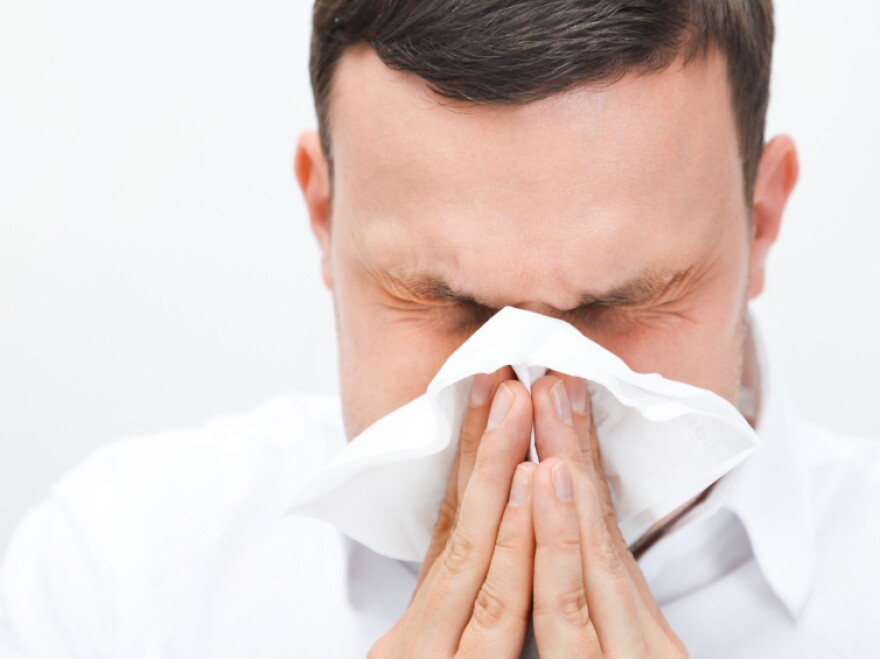What would it take to persuade you to allow government researchers to squirt millions of live flu viruses up your nose?
A recently concluded project at the National Institutes of Health found, among other things, that $3,400 each was enough to attract plenty of volunteers.
"I am happy I could contribute in some way," says Kelli Beyer, 24, one of 46 healthy people who volunteered for the project. To get the money, the research subjects had to commit to several days of testing, then nine days in a hospital isolation ward once the virus was administered in a nasal spray.
All the subjects got varying amounts of a laboratory-synthesized version of the H1N1 strain of swine flu that touched off a back in 2009 that sickened millions and contributed to the deaths of more than 18,000 people.
Since one aim of the study was to see how much virus it takes to make people moderately sick, researchers ramped up the dose given to seven successive groups of volunteers. Beyer was in the last of seven groups, so she got the highest dose.
More on what happened to her later. First, you might be wondering why scientists felt they needed to give people the flu.
"Despite 100 years of studying influenza, we still have somewhat limited knowledge of how flu causes disease in humans," study director Matthew Memoli tells Shots. "These kinds of studies have been done before, but not since the early 1990s."
Memoli, an infectious disease specialist at NIH's clinical center, that 5 to 20 percent of the population gets the flu each year. He says that only by deliberately infecting people with known quantities of a known flu virus can researchers understand how that virus behaves.
"In this study we know exactly when they were exposed, exactly when they got sick," Memoli says. And there's a lot of other important stuff too, such as how long after infection people become contagious, how long they're contagious, what the virus does to different tissues in the body, and how the body fights it off.
Memoli presented the first results of the study at a meeting of the in Denver.
He says science has changed a lot in the two decades since these kinds of experiments, called challenge studies, were last done with flu. The term signifies that volunteers are challenged with a microbe to see what happens.
"We have new tools for studying the immune response," he says. "We can look at gene expression — when you get infected with a virus what genes in your body get turned on or off — which we couldn't look at 20 years ago."
Advances in genetics also allow scientists to track the ways viruses evolve inside people's bodies once an infection gets going.
Scientists also have better tools for measuring people's immune response to flu — , that summon and activate immune cells, what specific and get activated.
All this, Memoli says, helps development of more effective vaccines and antiviral medicines against influenza.
One thing the recent study showed is how much virus is required to produce "mild to moderate" illness. The answer is a technical one: 10 million TCID50s. That is, 10 million times the amount of virus it takes to kill 50 percent of human cells cultivated in laboratory dishes. (The term stands for Tissue Culture Infective Dose.)
So how many viruses is that, exactly? "This is extraordinarily difficult to measure, and anyone who gave you an answer to that question would be making very big assumptions," Memoli says.
Suffice it to say that at least 10 million viral particles of the 2009 H1N1 influenza bug is enough to cause mild to moderate illness in 69 percent of people who get that dose.
One practical use of that information: Scientists now know (for this viral strain, anyway) that 69 percent of unvaccinated people will get sick when they get this dose. So any candidate vaccine has to lower that rate substantially to be considered effective.
The study showed that people begin shedding flu virus in their secretions between 24 and 72 hours after exposure. They began showing symptoms anywhere from one to five days after exposure. By the ninth day, they were no longer contagious.
Soon Memoli plans to begin another series of challenge experiments, this time involving 100 volunteers, to identify what protects humans from flu. What levels of which antibodies to the proteins on the viral surface make a difference?
It wouldn't be safe or ethical, by the way, to involve elderly people or children in such experiments. "By studying healthy people, we can learn what's missing in those who are elderly or young or have immune problems," Memoli says. That might lead to vaccines designed to "prop up these folks" more effectively.
A little further down the road, Memoli plans to do challenge studies with a different strain of flu now circulating called H3N2 that tends to cause more severe disease. He hopes to figure out why.
And so what happened to Kelli Beyer after she got her dose of 10-million-plus flu viruses? Nothing too terrible.
"Honestly, if I hadn't known it was H1N1, I would probably have assumed it was any old cold," she tells Shots. "I was tired, had a runny nose, spiked a fever. If I were outside the NIH, I would probably have taken some over-the-counter medicine and gone to work."
It wasn't bad enough, she says, to induce her to get a flu shot this fall, though she says she might if she had more contact with children or elderly people.
Copyright 2020 NPR. To see more, visit https://www.npr.org. 9(MDAxNDQ2NDAxMDEyNzU2NzM2ODA3ZGI1ZA001))







